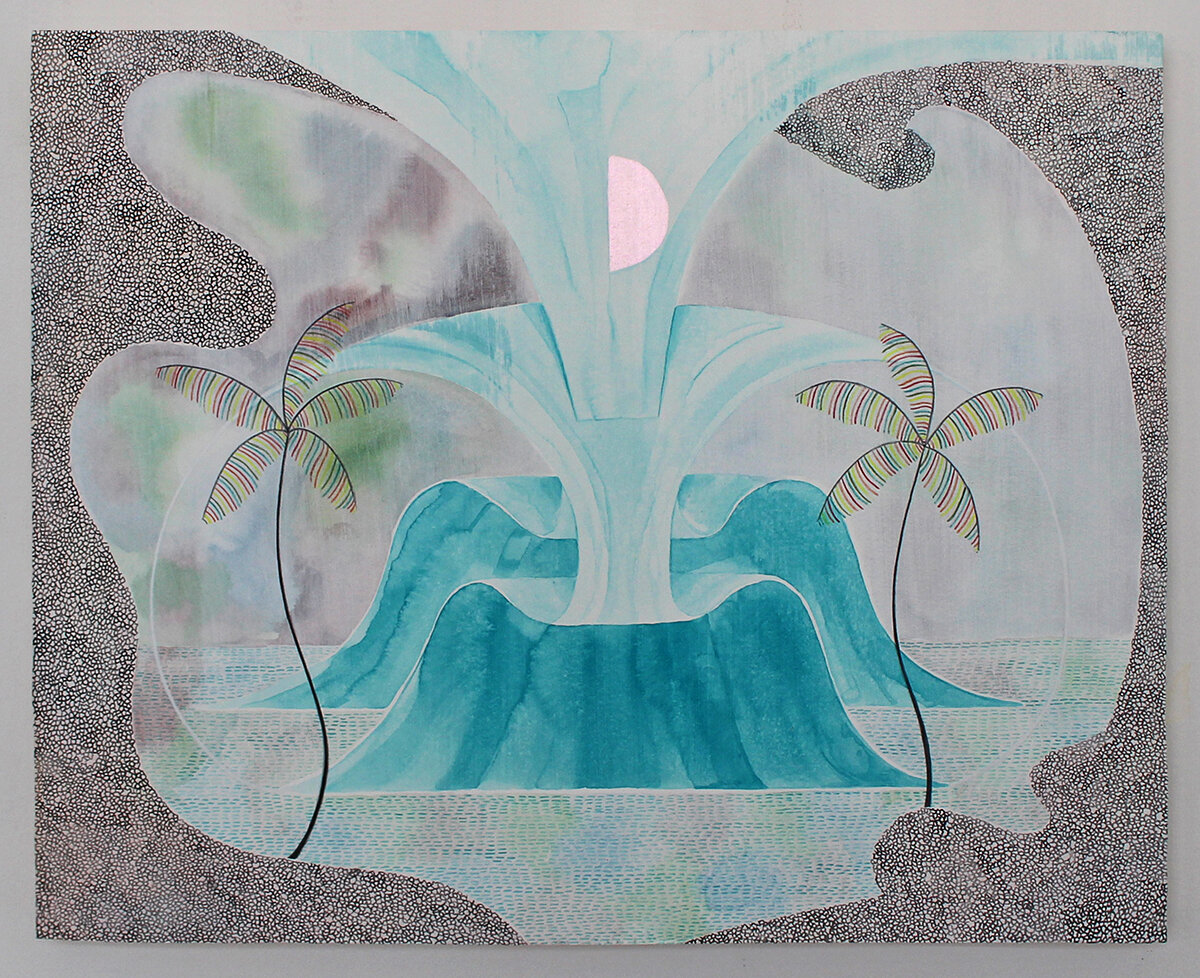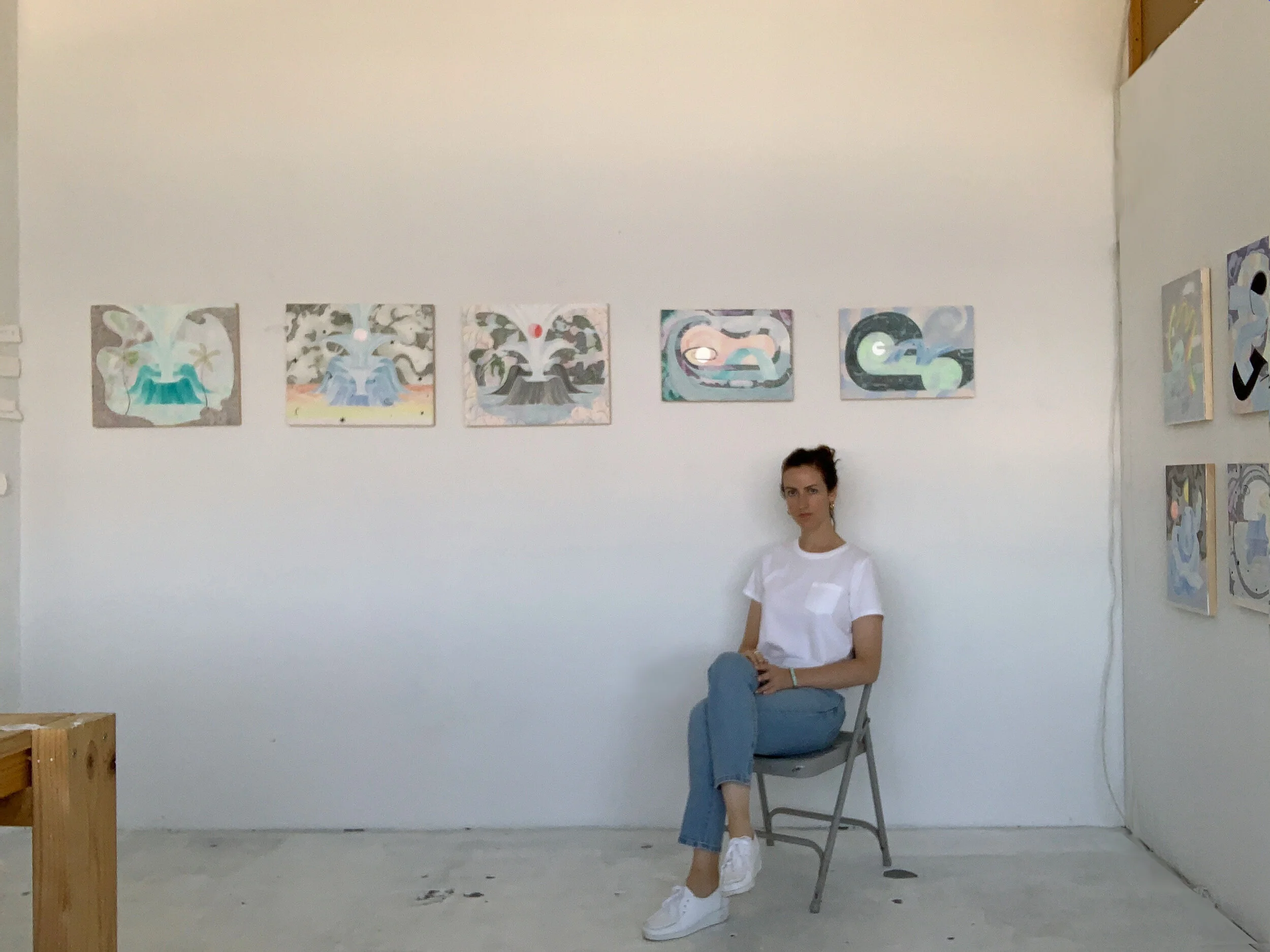Jessica Cannon
Jessica Cannon is an artist living and working in Brooklyn. She has had solo and two-person exhibitions at Honey Ramka, Not Gallery, and The Art Lot; and group exhibitions at Big Medium, One Mile Gallery, The Manes Center, Brooklyn Academy of Music, The Hudson Valley Center for Contemporary Art, Tinlark, and elsewhere. She is a past recipient of The Brooklyn Arts Council’s Community Arts Fund Grant and Lower Manhattan Cultural Council’s SwingSpace Residency on Governor’s Island. Select press and publications include: The New York Times, Flaunt Magazine, phaidon.com, New American Paintings, and Hyperallergic. She received her BA from Tufts University and her MFA from Parsons School of Design, where she currently teaches. In Fall 2017, Jessica founded Far x Wide, an ongoing series of art selections presented online and in available spaces to benefit social and environmental justice organizations.
Statement
I paint cosmic feminine landscapes that reflect individual and collective searching. This search happens along two orbits- out in the vast universe, as described by physics, and inside an interior world shaped by lived and felt experience. My paintings often feature waves in different formations – rising, leaning, merging into each other, crashing onto themselves. I like the universal and figurative quality of waves, and the durational aspect of something that takes a form, changes, and dissolves into a field. I grew up in NY and spent time by the water, accessing open space by visiting the beach or looking at the sky. Recently I began reading physics books and connected with their poetic descriptions of the universe. Two ideas resonated: first, the ocean and sky – the places I’ve returned since childhood, are made from the same materials as my body; and second, waves exist in everything from the invisible to the immense. These ideas help to form a visual language that describes where I overlap with the universe; through pleasure and destruction, feelings and questions, peace, doubt, and mystery.
Extension, 2018. Acrylic on paper adhered to panel, 16 x 20 inches
Interview with Jessica Cannon
Questions by Emilia Shaffer-Del Valle
Tell us a little about your background. How did you come to make art? What drew you to painting in particular?
I was always drawing as a kid and growing up there were a few experiences where making or looking at art registered with me in a deep way. I remember my mom helping to paint the backdrop for our Kindergarten play. I was so impressed with this painting, and also at the chance to stay after school and have the run of the art room while she was working. In middle school our art class took a museum trip and we stopped in front of a lithograph of Edvard Munch’s Scream. I’d never seen anything like it. The docent was talking but all I could think about was how this art was physically doing what it depicted. Growing up I was surrounded by creative and resourceful people but didn’t know anyone that worked as an artist, so it didn’t occur to me to go to college for art. In college, I majored in Psychology and English and took studio classes at the Museum School in Boston. I had a wonderful Experimental Drawing teacher, Robert Siegelman, that invited our class to visit his studio in Fort Point. I was a college senior and had never been to a studio before. I remember seeing his space and feeling a strong pull toward pursuing art but also feeling a little sad, as though at twenty-one I might have missed my chance.
My first job after college was working on academic psychology research partly done in a mental hospital. I hated this job and quit a few months in, but it was around this time in the fall of 2001, that I started pursuing art more seriously. Over the next year I waited tables and did other odd jobs while working on a portfolio to apply to grad school. I think I come to painting from drawing first, and am pulled in by the materiality of paint.
Relay, Collide, Repeat, 2019. Acrylic on paper adhered to panel, 16 x 20 inches
You’ve described your paintings as “cosmic feminine landscapes.” What spaces – real, metaphorical, imaginary, or other – are you looking to in making these paintings?
My paintings are informed by a variety of spaces – symbolic landscapes described through dreams and archetypes; places I encounter while traveling, and their variations in light and color; illusory space that I might see in NY, where so many different planes, textures, and colors get crowded into a small area; NASA satellite imagery; descriptions of things in physics books; how other artists treat space; my own place memories and feelings.
There are a couple of recurring motifs in your work – the wave and the moon. Can you tell us about their significance?
Sure! The moon is a relatively new element in my paintings but can be traced back to a very early memory: as a baby my mom would hold me up to the window before bedtime and ask if I could point to the moon. I grew up in NY and experienced open space by going to the beach or looking up at the sky. I think these things left deep imprints that came out later in my imagery. Similarly, I spent a lot of time looking at waves as a kid but they only entered my work in the last couple of years when I abandoned reference materials and started working from imagination. I like the figurative quality of waves – they have a duration, and can crest, lean, crash into each other, or fall on themselves.
The Return, 2018. Acrylic on paper adhered to panel, 12 x 18 inches
You’ve said that you are creating “a visual language that describes where I overlap with the universe.” Have you always felt such strong ties to nature? How has making art helped to define your relationship to the natural world?
I definitely have always felt a strong pull toward the natural world. I’m interested in the parts of it that we perceive through our senses but also the unknown parts. For me, making art enhances this sense of wonder and vastness. I love that you can draw a line on a small scrap of paper and get a horizon.
I’m interested in the role of ephemerality in your work. This seems most overt in some of the “walls” you’ve made (I’m thinking mostly of Permanent Tide), but many of your recent paintings also capture a feeling of dreamy impermanence. Can you tell us about that?
I try to embrace impermanence when it reveals itself. Rather than try to hold onto something tightly it feels better to know that everything is always changing. In my wall paintings those changes come from actual weather interacting with the work outside. When I work on paper or panel I go back and forth between fast and slow speeds in my mark-making. When these marks achieve a certain balance, it can make the spaces in the paintings seem like a moment between stillness and motion.
Fountain, 2019. Acrylic on paper adhered to panel, 24 x 30 inches
In looking at some of your past work, I noticed some text-based pieces. How do those paintings figure into your practice?
I haven’t made a text piece in a while but a few years ago I wrote something that became a five-part color field painting with excerpts of the text overlaid on each section. It didn’t lead to more text-based works but the words hinted at some of the imagery that came after. Maybe I didn’t know the images yet so they needed some words to help?
What is your process like in the studio?
I start with a quick pencil drawing and will sometimes do color studies on watercolor paper before moving to panel. The drawings outline a rough composition, which may get lost in the process. I begin by painting washes and depending on how the paint settles I’ll either continue adding washes or start working on some patterns. The marks can take a while but through that slowness I’m able to discover shapes that I wouldn’t naturally paint and that helps define the space in the paintings.
Blind Spot, 2019. Acrylic on paper adhered to panel, 16 x 20 inches
In addition to being an artist, you run a Far By Wide, a project that organizes thematic group exhibitions and art benefits. How did this project start?
After Hurricane Maria, I wanted to put together an online art benefit to support the relief efforts in Puerto Rico. While working on that project in early Fall 2017 I’d think about other kinds of disasters that were already in progress, or hadn’t arrived yet. That’s when the initial benefit idea changed from being a single project to an ongoing series of benefit exhibitions online and in available spaces to support social and environmental justice organizations.
Relatedly, how does your curatorial practice relate to your art-making practice? Do they inform each other? Do you see any similarities between the process of making art and the process of curating an exhibition?
The way that I approach curating is as an artist looking to collaborate with other artists. I’m always interested in that shared understanding of how tenuous it can be to make something and how intuition plays a role. In many ways, Far By Wide feels like an extension of my studio work while nourishing it at the same time.
Fountain in Space, 2019. Acrylic on paper adhered to panel, 24 x 30 inches
Who are some of the artists, writers, or musicians that you find inspiring? Do you find yourself mostly turning to other visual artists, or do other disciplines inform your work?
I’m inspired by many artists as well as disciplines outside art, like writing, physics, and music. Some art / artists that are never far away: Agnes Pelton, Hilma Af Klint, Paul Klee, Regina Pilawuk Wilson, Chris Ofili, Matthew Wong, Shara Hughes, Constantin Brancusi, Fred Tomaselli, Jack Whitten, Glenn Goldberg, Emily Weiner, Yashua Klos, Sonia Delaunay. Some music I have on in the studio: Ari Lennox, Delroy Wilson, David Bowie, Sharon Jones, Mac Miller, Johnny Cash, Dustin O’Halloran, The Cinematic Orchestra, Sonic Youth, Dinosaur Jr.. Favorite recent reads: Bluets by Maggie Nelson, Anything by Lydia Davis, The Secret Lives of Colors by Kassia St. Clair, any physics book by Carlo Rovelli, Fugitive Spring by Deborah Digges (a wonderful creative writing teacher of mine from college), Laurie Lisle’s biography of Georgia O’ Keefe.
Jessica Cannon in her Brooklyn studio.
What are you working on now? Which upcoming projects are you especially excited about?
I’m currently working on some large paintings in the studio, a couple of print projects, and an article for the first issue of Dovetail Magazine, which will be out this summer. I’m also very excited to be heading to the Jentel Artist Residency in Banner, Wyoming this October.
Thank you so much for your thoughtful insights, Jessica!
To find out more about Jessica and her work, check out her website.







